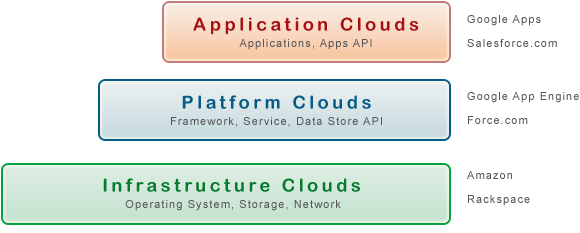Don’t Get Stuck in a Cloud
September 15th, 2009 by jeremychone
Mysterious, comforting, scary, and attractive are all possible adjectives to describe a cloud. Interestingly enough, this is true of all kinds of clouds, from the meteorological to the computing. During the last few years, we have a seen a proliferation of clouds forming from every corner of the Internet. Nowadays, it is very rare to see any Internet technology presentation without at least a few clouds.
So is cloud computing simply vaporware, or something tangible?
While the name might be “buzzy”, cloud computing is in fact a real phenomenon and does create great technological and business value. In fact, cloud computing is another step in the evolution of computing abstraction. First, hardware got abstracted with operating systems, then the user interface with the browser, and now, with cloud computing, the network is abstracted. Simply put, cloud computing allows one to build network applications without having to worry about the network.
So far, so good; but what is the catch?
As occurs often in software, the catch pertains to the openness of the technology and how locked in a user might become. Even the most open technologies have some degree of “lock-in.” The challenge is to mitigate the value of the service with the risk associated with being locked-in with a single provider.
There are only two important questions to consider, when assessing the lock-in of any software solution. How easy is it to get in? And how costly is it to get out?
You will receive much help from vendors to answer the first question, but you might find yourself on your own for the second one.
The challenge of cloud computing is that there are not yet any standards, and therefore, no vendor can claim to be “Cloud-4-Enterprise compliant.” However, the good news is that most vendors try to appear as familiar as possible and to reduce the learning curve as much as possible.
The degree of lock-in also depends upon the type of cloud used. Below are the three main types of clouds, with their respective benefits and risks:

From the bottom up:
1) Infrastructure Cloud
The infrastructure cloud virtualizes the hardware and network parts of the system. This includes the server hardware, operating
systems, network, and storage. Amazon has opportunistically and successfully established itself as the leader of this market.
In this scenario, the lock-in factor is rather low, since application developers still maintain full control of the technologies they utilize and can replicate it on any system. Moving out of an infrastructure cloud will incur an administration cost, but should not significantly impact the application code.
The downside of this approach is that, while it tremendously reduces the system management cost, this option still require some system management. For example, an application must be architected to scale multiple instances, and these instances must also be managed.
2) Platform Cloud
Platform clouds, such as the Google App Engine and Force.com, take the next step in abstraction and offer a complete virtualization of the application platform. Developers must only worry about the code of the application, and the cloud will complete the rest of the task.
The great advantage of this approach is that it reduces, almost to zero, any system administration, and the application can scale seamlessly across multiple instances, without requiring any management or special handling.
However, the seamless scalability has a price. To provide virtually infinite scalability, the platform cloud often restricts the environment in which the application can be written. For example, Force.com possesses its own Java-like language and custom MVC model. Though this is very powerful and complete, once an application is coded in Force.com, it must remain on Force.com forever. The Google App Engine is a more standard approach, as it does support Java. As of today, however, the data access layer supports only JDO and not the more commonly used SQL interface. This allows the Google App Engine to scale very effectively the data layer of the application. However, developers must rewrite their data-object layers with a less common interface (although JDO is still a standard and can be ported out of Google App Engine).
3) Application Cloud
The application cloud provides a hosted environment for third party applications to embed themselves within the service applications. For example, the application cloud allows the developer to extend Google apps or Salesforce.com functionalities.
Application clouds tend to be combined with platform clouds to enable deeper integration into the application. For example, while Saleforce.com does allow foreign application integration, it exposes many more integration points to applications hosted by Force.com. Consequently, to fully embed an application within Salesforce.com, employing Force.com might be the right decision. An option to mitigate risk is to develop only the integration points in the cloud specific platform and to keep the rest of the application as portable as possible.
Despite the high degree of vendor lock-in, the application cloud provides unparallel value because it allows third-party applications to fully leverage the service applications ecosystem.
Thus, as we can see, each type of cloud features both pros and cons. The good news is that as cloud computing becomes more popular, standards will emerge, and application portability will become a reality. For now, however, the most important thing is to be aware of the associated risks and to plan in accordance. In some cases, the benefits might surpass the risks, and in some other instances, the risks might not be worthwhile. In any case, do not believe the marketing slides and make your own experiments to truly assess the value and risk of each option.
If you liked this article a +1 on HN or a re-tweet are greatly appreciated. (see R-Tweets)
September 16th, 2009 at 3:11 am
[...] Don’t get stuck in a cloud – Eine sehr detaillierte Aufschlüsselung des derzeitigen Buzzwords “Cloud Computing” [...]
September 16th, 2009 at 1:30 pm
[...] discussed in the article “Don’t Get Stuck in a Cloud ,” cloud portability tends to be a factor related to the type of cloud one [...]